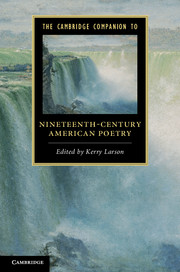Book contents
- Frontmatter
- Introduction
- I MANDATES, MOVEMENTS, AND MANIFESTOES
- 1 The reception of nineteenth-century American poetry
- 2 American Indian poetry in the nineteenth century
- 3 The poet as Poetess
- 4 Transcendentalist poetics
- 5 Slavery and its metrics
- 6 Weathering the news in US Civil War poetry
- 7 The “Twilight of the Poets” in the era of American realism, 1875–1900
- II INDIVIDUAL AUTHORS
- Selected guide to further reading
- Index
- Cambridge Companions to…
7 - The “Twilight of the Poets” in the era of American realism, 1875–1900
from I - MANDATES, MOVEMENTS, AND MANIFESTOES
Published online by Cambridge University Press: 28 November 2011
- Frontmatter
- Introduction
- I MANDATES, MOVEMENTS, AND MANIFESTOES
- 1 The reception of nineteenth-century American poetry
- 2 American Indian poetry in the nineteenth century
- 3 The poet as Poetess
- 4 Transcendentalist poetics
- 5 Slavery and its metrics
- 6 Weathering the news in US Civil War poetry
- 7 The “Twilight of the Poets” in the era of American realism, 1875–1900
- II INDIVIDUAL AUTHORS
- Selected guide to further reading
- Index
- Cambridge Companions to…
Summary
The terms “poetry” and “realism” have a complex and mostly oppositional relationship in American literary histories of the post-Civil War era. The conventional account holds that realism, the major literary “movement” of the era, developed apace in prose fiction, while poetry, stuck in a hopelessly idealist late-Romantic mode, languished and stagnated. By this all too-familiar account, American poetry produced little of value between Whitman and Dickinson and the modernists. Poetry is thus almost entirely absent from scholarship on American realism except as the emblem of realism's opposite: a desiccated genteel tradition. The long life of this tale in twentieth-century criticism has afforded it, until very recently, factual status, but its core elements did not in fact arise retrospectively from an impartial scholarly distance. Rather, the twentieth-century critics who promulgated this account reproduced the elements of a story already circulating during the last quarter of the nineteenth century. In the pages that follow, I will trace the narrative that poetry was in its “twilight” as it emerged in the last quarter of the nineteenth century, serving a particular ideology of poetry among elite poets and in highbrow literary periodicals; I will also argue that poetic counter-discourses in the era itself invalidate the standard narratives about postbellum poetry and its relation to realism.
Nancy Glazener has penetratingly argued that “realism” was an institutional product of a cluster of highbrow periodicals she calls “the Atlantic Group.” The “twilight of the poets” also became a lively topic circulating in this elite literary sphere. After Edmund Clarence Stedman published the term in 1885, it spread rapidly through literary culture and became an almost instant catchphrase, a sensationalist coin that writers enjoyed trading amidst their broader discussions about the degraded literary status, or status in general, of the modern era.
- Type
- Chapter
- Information
- The Cambridge Companion to Nineteenth-Century American Poetry , pp. 135 - 154Publisher: Cambridge University PressPrint publication year: 2011
- 3
- Cited by



